Mangalakudi, revered as 'Pancha Mangala Sthalam', embodies five aspects imbued with auspiciousness and spiritual significance. The very name of the place, Mangalakudi, resonates with divine blessings, as does the name of the presiding female deity, Mangalambikai, whose grace is said to bestow prosperity and well-being upon devotees. The temple's vimana, is known as the 'Mangala Vimanam', while the resident Vinayaka, is affectionately called Mangala Vinayaka. The sacred waterbody associated with the temple, is called the 'Mangala theertham', rounding out the five-fold auspiciousness of Mangalakudi. The temple complex itself is an impressive sight, featuring a grand five-tiered Rajagopuram that towers over the surrounding landscape and two concentric prakarams that encircle the inner sanctum. The sthala vruksham, or sacred tree associated with the temple, is the rubber bush tree, known in Sanskrit as kongilavam. Within the temple precincts, the sannidhi of Mangalambikai, facing southward, occupies a prominent place in the front enclosure. The main deity residing in the sanctum sanctorum is a swayambhu linga, characterized by a tall, protruding 'Bana'. The temple also houses 'urchava' idols of Chandrashekara, Mayil Vahanar, the four primary nayanmars, and Pradosha nayaka, which are taken out in procession during festive occasions. The 'Goshta Murthas', or subsidiary deities, include Dakshninamurthy, Rishabarudar, Brahma, and Durga, each with their own shrines within the temple complex. The inner prakaram is home to sannidhis for Vinayaka, Arumukha, Gajalakshmi, Bhairavar, and the nataraja sabha, where Lord Shiva is worshipped in his cosmic dance form. Interestingly, the temple boasts two urchava idols of Nataraja, one of which is taken out for procession during the 'Aani tirumanjanam' festival, while the other is reserved for the 'Aarudhra Darshan' celebration.
Mangalambikai, the revered deity at this temple, is believed to possess the divine power to remove obstacles related to marriage, strengthen the longevity and well-being of one's spouse, and bestow devotees with health and prosperity. This belief is rooted in the numerous experiences and testimonials of devotees who have sought Mangalambikai's blessings. A particularly notable ritual involves offering curd rice served on the leaf of the sacred rubber-bush tree for 12 consecutive Sundays, starting from the first Sunday of the Tamil month Karthigai. By partaking in this offering and consuming the consecrated curd rice, devotees have reported remarkable improvements in their health and even the alleviation of various ailments. The temple has witnessed countless individuals who have found relief and healing through this sacred practice. Furthermore, the temple's 'uchi kala pooja' is followed by the distribution of curd rice served on rubber-bush leaves as 'Prasad'. Performing 'Annadanam' (food donation) at this temple on Sundays is considered highly beneficial for those afflicted by astrological conditions such as 'Ashtama Sani', '7 1/2 Sani', and 'dasabhukthi dosha'. The sacred yellow thread known as 'mangalya saradu', which adorns the holy hands of Mangalambikai, is bestowed upon female devotees. Many devotees undertake the practice of praying to Mangalambika for five consecutive Fridays to alleviate 'Mangalya dosha' and 'Kalathra dosha', seeking her grace in finding a suitable marriage prospect. Additionally, performing the ritual of 'abisheka' to the Agastheeswara Linga at this temple on the new moon day is believed to mitigate sins from one's previous birth and provide relief from 'pithru Shaapa' (ancestral curses).
The ancient Shiva temple of Tirumangalakudi, holds immense spiritual significance due to the legendary worship performed there by divine beings and enlightened saints. It is believed that the radiant Sun God Sooriya, Maha Vishnu, Goddess Kali, Brahma, and Saint Agasthiyar have offered their devotion to Lord Shiva residing here. The temple's history is further enriched by the captivating tale of Alaivaanar, a devoted minister under the reign of the illustrious Chola King First Kulothungan. In an act of unwavering piety, Alaivaanar allocated the entirety of the state's tax revenues and financial resources towards the renovation and embellishment of the Tirumangalakudi Shiva temple. Upon learning of this audacious deed, the king summoned Alaivaanar to his presence. Consumed by trepidation and the fear of retribution for his unauthorized use of government funds, the minister, in a moment of despair, took his own life. His wife, an ardent devotee of Lord Shiva herself, transported her husband's mortal remains to Tirumangalakudi for the final rites of cremation. As she approached the sacred grounds, she fervently invoked the grace and intervention of Lord Shiva and his divine consort, Mangalambikai. In a display of divine benevolence, the minister was restored to life, his soul reunited with his physical form. In commemoration of this extraordinary event, the presiding deity of the temple came to be known as Praana Natheswarar, the bestower of life itself, while the goddess assumed the name Mangalambikai, the grantor of auspiciousness and divine union.
The temple of Tirumangalakudi, holds a revered place among the sacred sites believed to possess the power to negate the inauspicious influences of the nine celestial bodies known as the Navagrahas. According to local legend, the temple's origins are inextricably linked to the plight of a sage named Kalapa, who, skilled in the art of reading birth charts, became aware of his own dire fate - that he was destined to be afflicted with the scourge of leprosy. Desperate to avoid this terrible destiny, Kalapa turned to the nine planetary deities, fervently praying for their intervention on his behalf. In response to his heartfelt supplications, the Navagrahas manifested before him, granting him reprieve from the disease that awaited him. However, this act of celestial benevolence incurred the wrath of Brahma, the supreme creator, who admonished the Navagrahas for overstepping their authority and interfering with the immutable laws of karma. As punishment for their transgression, Brahma cursed the nine deities, condemning them to suffer the very same affliction that had threatened the sage. Stricken with leprosy, the Navagrahas sought counsel from Brahma, who advised them to journey to a forest of rubber-bush trees, now known as Suryanar Koil, and commence their penitence on the first Sunday of the Tamil month of Karthigai. For twelve consecutive Sundays, the deities diligently followed a sacred ritual, bathing in the nine holy water bodies surrounding the area, and on the following Monday, immersing themselves in the sacred waters of the Kaveri River before worshipping at the shrines of Prana Natheswar and Managalambikai. Through their unwavering devotion and adherence to these divine instructions, the Navagrahas were ultimately able to free themselves from Brahma's curse and were miraculously cured of their leprosy. Today, the Tirumangalakudi temple stands as a testament to this ancient legend, and those who embark on a pilgrimage to the Navagraha temples are advised to begin their journey at this hallowed site before proceeding to the temple dedicated to the Sun, Suryanar Koil. Adding to the temple's mystical aura is the presence of a unique Vilva tree within its sacred garden, whose leaves are distinguished by the unusual characteristic of possessing eleven petals, further underscoring the profound spiritual significance of this ancient place of worship.
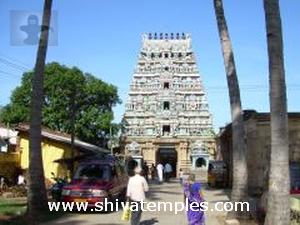 5 Tiered Tower
5 Tiered Tower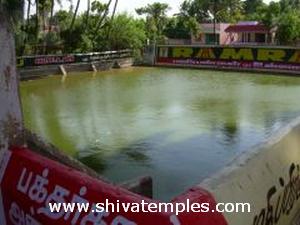 Mangala Theertham
Mangala Theertham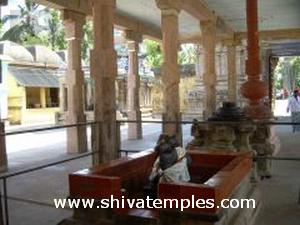 Nandi, altar, flagstaff
Nandi, altar, flagstaff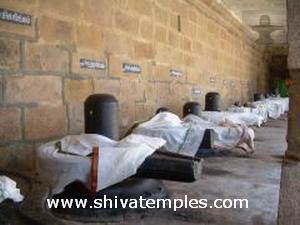 A line up of Linga
A line up of Linga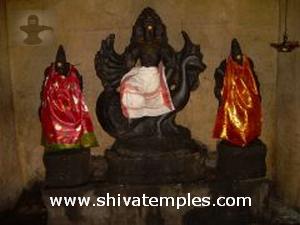 Subramanya with Valli,Deivanai
Subramanya with Valli,Deivanai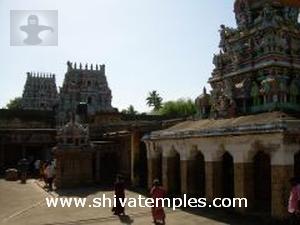 Inside View
Inside View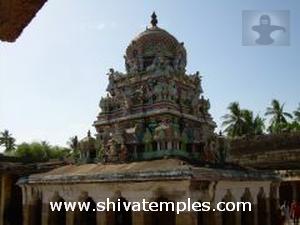 Mangala Vimana
Mangala Vimana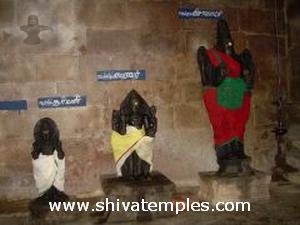 Surya, Bharivar, Vislakshi
Surya, Bharivar, Vislakshi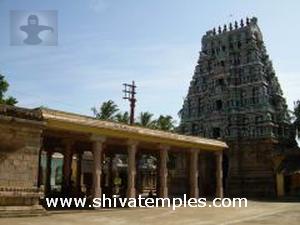 View of Gopuram from inside the temple
View of Gopuram from inside the temple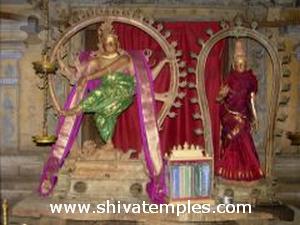 Nataraja, Shivakami
Nataraja, Shivakami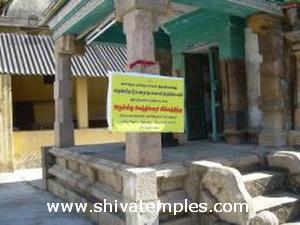 Agatheeswar sannidhi
Agatheeswar sannidhi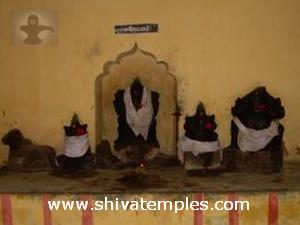 4 Vinayaka, Nandi
4 Vinayaka, Nandi